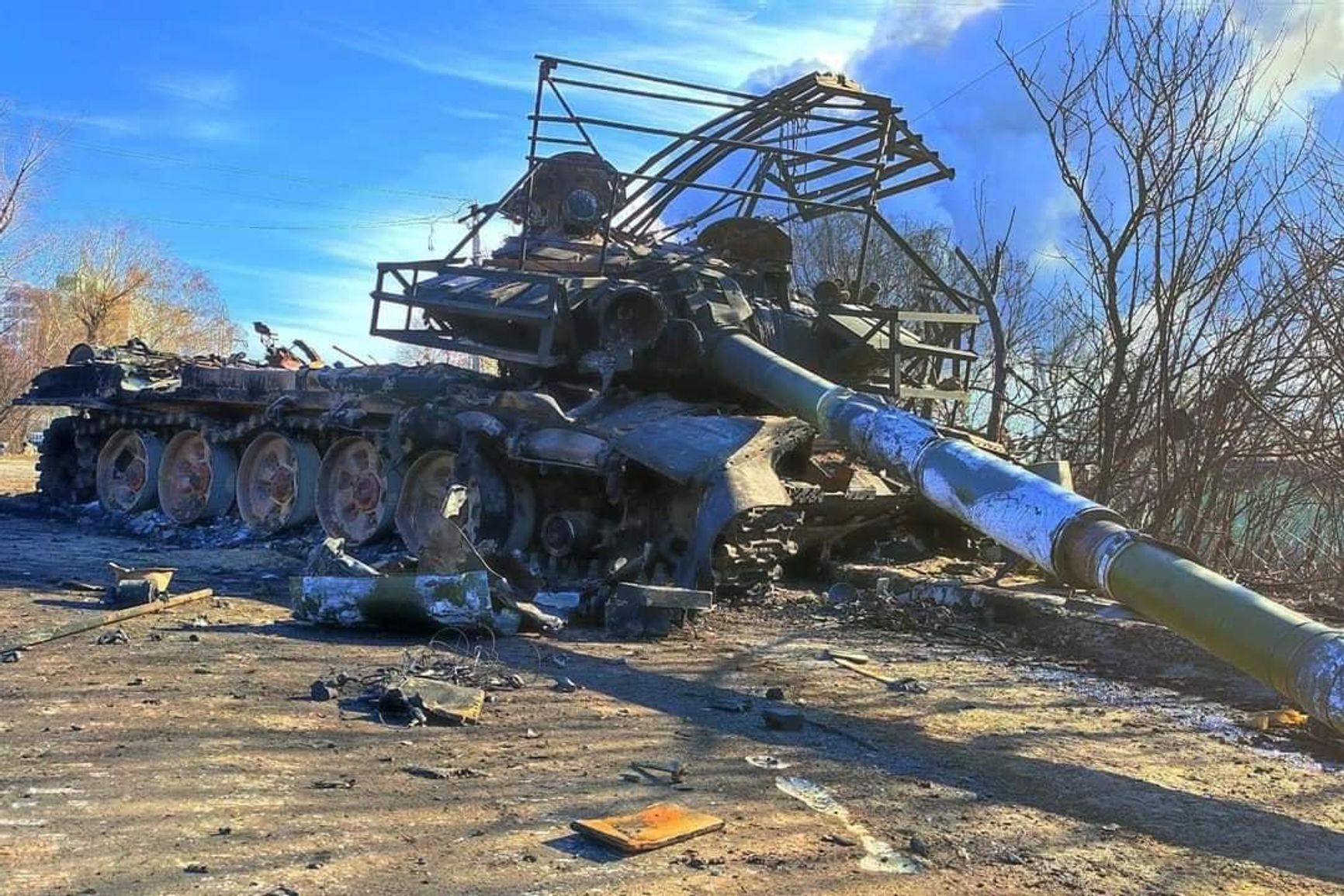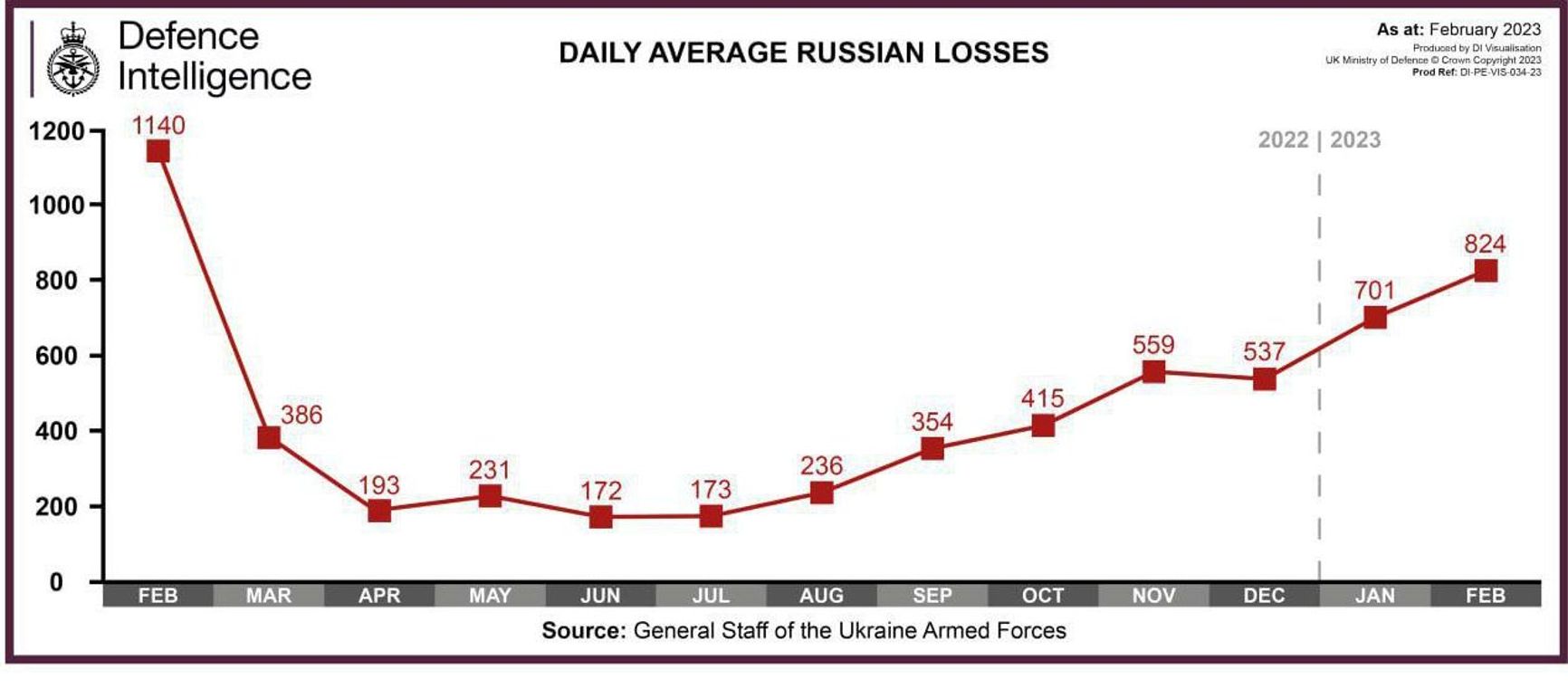Russia storms Bakhmut, Iran delivers new batch of drones, NATO warns of ammunition shortage. What happened on the front line on February 13?
Читать на русском языке
The front line
Russian forces have launched a new large-scale offensive on Bakhmut on the eve of the one-year anniversary of the war, said NATO Secretary General Jens Stoltenberg . The town has been subjected to heavy artillery fire, Reuters reported, citing Ukrainian military officials.
Russian troops advancing on Bakhmut are constantly changing tactics, either attacking in small assault groups or engaging dozens of mobilized men for the assault, wrote the Telegram channel Operative AFU (“Operativny VSU”). The Russian army sometimes intensifies its shelling at night, with rocket attacks targeting towns and civilian infrastructure behind the front line, the channel noted.
In the Kupiansk and Lyman directions, Russian forces shelled Ukrainian positions from tanks, mortars and artillery, the AFU’s daily report said, adding that Ukraine’s air force carried out 14 strikes on areas of Russian troop and equipment concentration during the day.

On February 13, the Russian Defense Ministry reported the capture of the settlement Krasna Hora near Bakhmut. A day earlier, the founder of the Wagner PMC, Yevgeny Prigozhin, had announced the same. The AFU denied the loss of Krasna Hora: Serhiy Cherevatyi, spokesperson for the Eastern Grouping of Ukraine’s Armed Forces, told CNN that fighting for the town continued, with the settlement remaining under the control of the Ukrainian army.
Russia continued to build defensive fortifications in the central part of Ukraine’s Zaporizhzhia region, particularly near the town of Tarasivka, the British Defense Ministry said in a February 13 report. According to satellite images, defensive installations are also being built between the village of Vasilyvka and the town of Orikhiv. According to British military intelligence, although the main fighting is taking place in Donbas, the Russian command is concerned about its defensive positions along the entire front line, which amounts to approximately 1,288 km. “This is demonstrated by continued construction of defensive fortifications in Zaporizhzhia and Luhansk oblasts and deployments of personnel,” the update read.
Shelling
A report by the AFU published on the evening of February 13 stated that Russian forces carried out two missile strikes, 16 air strikes and 15 strikes from multiple launch rocket systems (MLRS) on Ukrainian territory in the past 24 hours..
Twelve Ukrainian strike drones launched from the direction of Odesa and Mykolaiv were shot down in Crimea near Dzhankoi on February 13, claimed Russian publication Voennoe Obozrenie (“Military Review”). Another drone was shot down near Kerch.
Losses
Russia lost 103 pieces of equipment, including 36 tanks, during the three days (February 8-10) of the offensive on Avdiivka and Vuhledar, reported Dutch OSINT project Oryx. Ukraine lost 20 pieces of equipment during the same period, including two tanks. The calculations indicated a 5:1 loss ratio by the evening of February 10.
According to Oryx, the overall ratio of Russian and Ukrainian losses (as of February 11) was 9,189 to 2,941, or 3.12 to 1. As of February 14, those figures have gone up to 9,224 and 2,965 respectively, meaning the ratio is now 3.11 to 1.

During the failed assault on Vuhledar, the Russian army lost between 150 and 300 marines daily, according to a Politico report citing Ukrainian military spokesman Oleksiy Dmytrashkivskyi. According to the publication, Russia lost about 130 pieces of equipment, including 36 tanks, in the past week.

In the past two weeks, the Russian army has probably suffered its heaviest losses since the first week of the full-scale invasion of Ukraine, the British Defense Ministry reported on February 12. The ministry stressed that while it could not confirm the specific figures or methodology cited by the AFU General Staff, “the trends the data illustrated were likely accurate,” indicating that Russia’s casualty rate had increased. According to the Ukrainian General Staff, Russia’s losses over the past week have averaged 824 people a day, which is over four times the losses the Russian army suffered in June and July.
According to statistics released by the AFU General Staff on February 13, total Russian losses since the start of the invasion have amounted to 138,340.

Mobilized troops from the 51st Tula Airborne Regiment, attached to the Wagner PMC, break their arms and legs while on leave to avoid returning to the front under Wagner’s command, Russian military blogger and expert Andrei Morozov (“Fighting Cat Murz”) reported on his Telegram channel. According to him, the mobilized fighters are deliberately injuring themselves because of threats they receive from Wagnerites while working to evacuate their wounded: “We’ll shoot you if you don’t retrieve our guy.” Morozov also claims that all humanitarian aid sent to the 51st Airborne Regiment ends up in the hands of Wagner mercenaries.
Three Russian mob bosses, who were recruited by the Wagner PMC in penal colonies across the country, have been killed in Ukraine, reported investigative group Bellingcat. 59-year-old Sergei Maksimenko, 55-year-old Andrei Berezhnykh and 55-year-old Igor Kusk were accused of numerous murders and organizing three organized crime groups.
Ukraine launches production of M-16
Ukraine has started production of American M-16 assault rifles, The Moscow Times reported, citing a source close to the AFU. UkrOboronServis, a Ukrainian state-held defense industry company, had earlier signed a memorandum with the US-based weapons and aviation producer Aeroscraft, with the firms’ pilot project being a special version of the M-16 rifle adapted for use by the Ukrainian army. The modification assumed the name M4-WAC47. The new version of the M16 will be produced for 7.62×39 millimeter cartridges – the kind used in the Kalashnikov AK-47 and AKM assault rifles, which are in service with the AFU.

Arms supplies
Iran has supplied Russia with 18 new-type armed drones since last November, The Guardian reported citing its own sources in the Middle Eastern country. According to the newspaper, the weapons – 12 Shahed-129 and Shahed-191 drones and six Mohajer-6 drones – were transported via the Caspian Sea, where they were passed over from Iranian ships to the Russian Navy. The publication noted that the Mohajer-6 drone carries two missiles under each wing and has a range of about 200 kilometers, while the Shahed drones have an air-to-ground strike capability.
The war in Ukraine is depleting allies’ ammunition supplies, warned NATO Secretary General Jens Stoltenberg. A February 14 meeting of defense ministers will focus on finding ways to ramp up ammunition production. “For example, the wait for large caliber ammunition has increased from 12 to 28 months. Orders placed today will only be delivered two and half years later,” he said during a press conference in Brussels, adding that the depleted stockpile puts defense ministries under strain. “We need to ramp up our production and production capacity,” the official added.
Ukrainian tank crews start training on Leopards
Polish authorities have released photos and videos from a training ground where Ukrainian servicemen are learning to use Leopard 2A4 tanks.
Efficiency of Russian military propaganda on the decline – ISW
In its latest report, the US-based Institute for the Study of War (ISW) analyzed the methods used by Russian propaganda aimed at supporting certain goals at the front or mitigating the consequences of military defeats. In particular, the experts concluded that the numerous nuclear strike threats made by the Russian authorities in September and November were an attempt to “to reestablish deterrence and dissuade the West from providing Ukraine the materiel needed to continue its counteroffensives following devastating Russian military failures in Kharkiv Oblast.”
“It is now clear that the Russian information campaign centering on peace negotiations that intensified in December 2022 was aimed—among other things—at delaying the provision of Western tanks and other advanced equipment essential for the continuation of Ukrainian mechanized counteroffensives in order to set conditions for Russia’s own planned offensives,” the report said. ISW experts also believe that Moscow is constantly exaggerating its successes in the Bakhmut direction, but “the impact of such information operations is waning—both Ukraine and pro-war Russian nationalists have become less willing to accept claims of inevitable Russian victory at face value because of the year of Russian military incompetence.»
“We thought we’d be fighting Poles and mercenaries,” say Wagner fighters
Two former Russian prisoners, recruited by the Wagner PMC and captured by Ukraine, recently spoke to CNN, detailing the hideous losses and executions they had witnessed. According to one of them, he fought as part of a group of 90 people, 60 of whom were killed in the first assault near the village of Bilohorivka.
“We couldn’t retreat without orders because if we don’t comply with the order, we will be killed,” said one of the prisoners.
“One man stayed at a position, he was really scared, it was his first assault. We received an order to run forward. But the man hid under a tree and refused. This was reported to the command and that was it. He was taken 50 meters away from the base. He was digging his own grave and then was shot.”
The former prisoners claim that the Wagner Group lied to lure them into the war and that the recruits had no idea what was really going on in Ukraine. “We thought we’d be fighting Poles and various mercenaries. Germans. We didn’t think anyone was left in the Ukrainian army there. We thought they’d left the country,” said one of the men.
